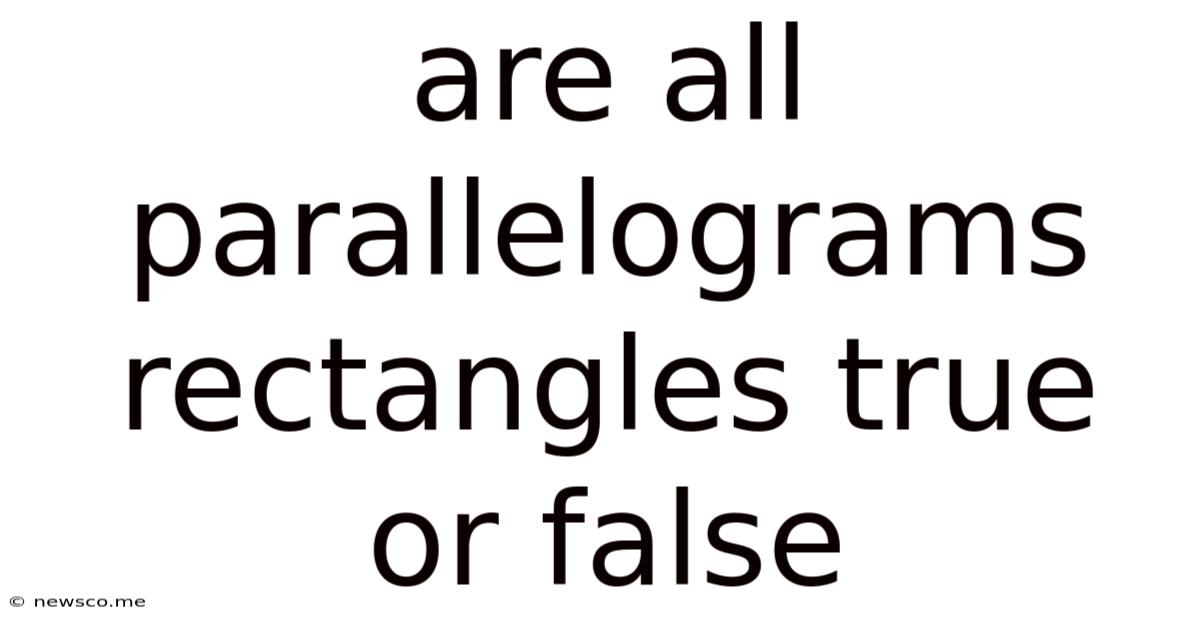Are All Parallelograms Rectangles True Or False
News Co
Apr 20, 2025 · 4 min read

Table of Contents
Are All Parallelograms Rectangles? True or False? A Deep Dive into Quadrilaterals
The statement "All parallelograms are rectangles" is false. While rectangles are a type of parallelogram, not all parallelograms possess the defining characteristics of a rectangle. This seemingly simple question opens the door to a fascinating exploration of geometric properties, definitions, and the hierarchical relationships between different quadrilaterals. Let's delve into the specifics.
Understanding Parallelograms
A parallelogram is a quadrilateral (a four-sided polygon) with two pairs of parallel sides. This is its defining characteristic. Consider the properties that stem directly from this definition:
- Opposite sides are parallel: This is the fundamental definition.
- Opposite sides are equal in length: Because of the parallel lines, opposite sides must be congruent.
- Opposite angles are equal in measure: Again, a consequence of the parallel lines and the properties of transversal lines.
- Consecutive angles are supplementary: This means that the sum of any two angles next to each other is 180 degrees.
Understanding Rectangles
A rectangle is a quadrilateral with four right angles (90-degree angles). This seemingly simple addition dramatically changes the properties of the shape. Key characteristics include:
- All angles are 90 degrees: This is the defining property of a rectangle.
- Opposite sides are parallel: This property is inherited from its parallelogram parentage.
- Opposite sides are equal in length: This property, too, is inherited from the parallelogram family.
- Diagonals are equal in length and bisect each other: Unlike parallelograms in general, the diagonals of a rectangle possess these extra qualities.
The Crucial Distinction: Why Not All Parallelograms Are Rectangles
The critical difference lies in the angle measurements. A parallelogram only requires parallel sides; its angles can be any value as long as opposite angles are equal and consecutive angles are supplementary. A rectangle, however, must have four 90-degree angles.
Imagine a parallelogram with angles of 60, 120, 60, and 120 degrees. This perfectly fits the parallelogram definition but utterly fails the rectangle definition. The sides are parallel, opposite sides are equal, but the angles are not all 90 degrees. Therefore, it is a parallelogram but not a rectangle.
Hierarchical Relationships in Quadrilaterals
To understand the relationship between parallelograms and rectangles more clearly, let's consider the broader family of quadrilaterals. Think of it as a hierarchy:
- Quadrilaterals: The broadest category, encompassing all four-sided polygons.
- Trapezoids: Quadrilaterals with at least one pair of parallel sides. Note that parallelograms are not trapezoids unless they are degenerate cases where parallel sides overlap.
- Parallelograms: Quadrilaterals with two pairs of parallel sides. This is where rectangles fit in.
- Rectangles: Parallelograms with four right angles.
- Squares: Rectangles with all four sides equal in length.
- Rhombuses: Parallelograms with all four sides equal in length.
This hierarchy shows that rectangles are a subset of parallelograms. All rectangles are parallelograms, but not all parallelograms are rectangles. Think of it like this: all squares are rectangles, but not all rectangles are squares. The same principle applies to parallelograms and rectangles.
Visualizing the Difference
Consider these examples:
-
Parallelogram (not a rectangle): Imagine a slanted rectangle – a parallelogram with angles other than 90 degrees. The sides are still parallel, but the angles aren't right angles.
-
Rectangle (and a parallelogram): A classic rectangle satisfies both the parallelogram and rectangle definitions. The sides are parallel, and the angles are all 90 degrees.
-
Square (and both a rectangle and parallelogram): A square fulfills all criteria: parallel sides, 90-degree angles, and equal side lengths.
Real-World Applications
Understanding the difference between parallelograms and rectangles has real-world applications in various fields:
-
Engineering and Architecture: Designing buildings and structures often involves understanding the properties of different shapes, including parallelograms and rectangles. The stability and strength of a structure depend on the angles and side lengths of its components.
-
Computer Graphics and Game Development: Creating and manipulating 2D and 3D shapes in computer software relies heavily on geometric principles. Knowing the differences between parallelograms and rectangles is crucial for accurate rendering and animation.
-
Physics: Analyzing forces and motion often involves understanding the geometry of objects and the shapes they form. The properties of parallelograms and rectangles are important in calculating vectors and forces.
Common Misconceptions and Clarifications
A common misunderstanding arises from the visual similarity of some parallelograms to rectangles. If a parallelogram is drawn with angles that appear close to 90 degrees, it can be easy to mistake it for a rectangle. However, the only way to definitively determine if it is a rectangle is to measure the angles or use other geometric properties to prove that all four angles are precisely 90 degrees.
Another misconception stems from the focus solely on the parallel sides. While parallelism is a necessary condition for a parallelogram, it's not sufficient to define a rectangle. The angles must also be 90 degrees.
Conclusion: The Importance of Precise Definitions
The statement "All parallelograms are rectangles" is demonstrably false. While rectangles are a special type of parallelogram, the inclusion of right angles as a defining characteristic distinguishes them. Understanding the precise definitions and hierarchical relationships within the family of quadrilaterals is essential for accurate geometric reasoning and problem-solving in various fields. The subtle but significant difference between these shapes highlights the importance of precise mathematical language and the careful consideration of all defining properties. Failing to grasp these distinctions can lead to errors in calculations, designs, and analyses across numerous disciplines.
Latest Posts
Related Post
Thank you for visiting our website which covers about Are All Parallelograms Rectangles True Or False . We hope the information provided has been useful to you. Feel free to contact us if you have any questions or need further assistance. See you next time and don't miss to bookmark.